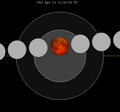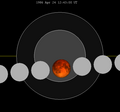
A total lunar eclipse took place on Sunday 9 November 2003, the second of two total lunar eclipses in 2003, the first being on 16 May 2003. It is the first total lunar eclipse of 21st century which happened on a micromoon day. The Moon barely edged into total eclipse for 21 minutes and 58 seconds. With the Moon just 1.78% of its diameter into the Earth's umbral shadow, the Moon may have been quite bright, but even so, this should have been worth seeing. The partial eclipse lasted for 3 hours, 31 minutes and 25 seconds. Occurring only 1.4 days before apogee, the Moon's apparent diameter was 6.4% smaller than average.

A partial lunar eclipse took place on Monday 17 October 2005, the second of two lunar eclipses in 2005. A tiny bite out of the Moon may have been visible at maximum, though just 6.25% of the Moon was shadowed in a partial eclipse which lasted for nearly 56 minutes and was visible over east Asia, Australasia, and most of the North America. A shading across the Moon from the Earth's penumbral shadow should have been visible at maximum eclipse.

A penumbral lunar eclipse took place on Sunday 30 December 2001, the last of three lunar eclipses in 2001. At maximum eclipse, 89.477% of the Moon's disc was partially shaded by the Earth, which caused a slight shadow gradient across its disc; this subtle effect may have been visible to careful observers. No part of the Moon was in complete shadow. The eclipse lasted 4 hours, 4 minutes and 17.7 seconds overall. This lunar eclipse followed the Annular Solar Eclipse on 14 December 2001.

A penumbral lunar eclipse took place on Sunday, January 31, 1999, the first of two lunar eclipses in 1999.
A total lunar eclipse took place on Monday, October 28, 1985, the second of two total lunar eclipses in 1985, the first being on May 4, 1985.
A penumbral lunar eclipse took place on Tuesday, April 14, 1987, the first of two lunar eclipses in 1987, the second being on October 7, 1987. This subtle penumbral eclipse may have been visible to a skilled observer at maximum eclipse. 77.703% of the Moon's disc was partially shaded by the Earth, which caused a gentle shadow gradient across its disc at maximum; the eclipse as a whole lasted 3 hours, 54 minutes and 12.8 seconds. The Moon was just 4.6 days before perigee, making it 0.5% larger than average.
A penumbral lunar eclipse took place on Thursday, November 8, 1984, the last of three lunar eclipses in 1984. This subtle penumbral eclipse may have been visible to a skilled observer at maximum eclipse. 90% of the Moon's disc was partially shaded by the Earth, which caused a gentle shadow gradient across its disc at maximum; the eclipse as a whole lasted 4 hours and 28 minutes.
A penumbral lunar eclipse took place on Tuesday, May 15, 1984, the first of three lunar eclipses in 1984. This was a deep penumbral eclipse, with the southern limb of the Moon close to the Earth's shadow.
A penumbral lunar eclipse took place on Tuesday, December 20, 1983, the second of two lunar eclipses in 1983. At the maximum eclipse, 89% of the Moon's disk was partially shaded by the Earth, which caused a slight shadow gradient across its disc; this subtle effect may have been visible to careful observers. No part of the Moon was in complete shadow. The eclipse lasted 4 hours and 2 minutes overall.
A penumbral lunar eclipse took place on Tuesday, January 20, 1981, the first of two lunar eclipses in 1981. In a rare total penumbral eclipse, the entire Moon was partially shaded by the Earth, and the shading across the Moon should have been quite visible at maximum eclipse. The penumbral phase lasted for 4 hours and 24 minutes in all, though for most of it, the eclipse was extremely difficult or impossible to see. The moon's apparent diameter was larger because the eclipse occurred 5.2 days after perigee.

A penumbral lunar eclipse occurred on Friday, 5 May 2023, the first of two lunar eclipses in 2023. The moon's apparent diameter was 0.1% larger than average because it occurred 5.5 days before perigee. This was the deepest penumbral eclipse since February 2017 and until September 2042.

A partial lunar eclipse occurred on Saturday, 28 October 2023 (UTC).

A penumbral lunar eclipse will take place on Tuesday, August 17, 2027. It will cause a subtle dimming as 54.56% of the Moon will cross within Earth's penumbral shadow.

A total lunar eclipse took place on Wednesday, October 18, 1967, the second of two total lunar eclipses in 1967, the first being on April 24, 1967.
A penumbral lunar eclipse took place on Wednesday, April 2, 1969, the first of three penumbral lunar eclipses in 1969, the second being on Wednesday, August 27, and the last being on Thursday, September 25. This subtle penumbral eclipse may have been visible to a skilled observer at maximum eclipse. 70.337% of the Moon's disc was partially shaded by the Earth, which caused a gentle shadow gradient across its disc at maximum; the eclipse as a whole lasted 3 hours, 43 minutes and 46.9 seconds. Occurring only 4.2 days before perigee, the Moon's apparent diameter was 0.9% larger than average.

A penumbral lunar eclipse took place on Wednesday, May 4, 1966, the first of two penumbral lunar eclipses in 1966. It was visible from South America, Europe, Africa, Asia, Australia and Antarctica.

A penumbral lunar eclipse took place on Wednesday, December 8, 1965. At maximum eclipse, 88% of the Moon's disc was partially shaded by the Earth, which caused a slight shadow gradient across its disc; this subtle effect may have been visible to careful observers. No part of the Moon was in complete shadow. The eclipse lasted 4 hours and 1 minute overall.

A hybrid solar eclipse occurred on Thursday, April 20, 2023. A solar eclipse occurs when the Moon passes between Earth and the Sun thereby totally or partly obscuring the Sun for a viewer on Earth. A hybrid solar eclipse is a rare type of solar eclipse that changes its appearance from annular to total and back as the Moon's shadow moves across the Earth's surface. Totality occurs in a narrow path across the surface of the Earth, with the partial solar eclipse visible over a surrounding region thousands of kilometers wide. Hybrid solar eclipses are extremely rare, occurring in only 3.1% of solar eclipses in the 21st century.

A penumbral lunar eclipse took place on Friday, March 23, 1951. This subtle penumbral eclipse may have been visible to a skilled observer at maximum eclipse. 64% of the Moon's disc was partially shaded by the Earth, which caused a gentle shadow gradient across its disc at maximum; the eclipse as a whole lasted 3 hours and 34 minutes.

A penumbral lunar eclipse took place on Sunday, March 12, 1933. This very subtle penumbral eclipse was essentially invisible to the naked eye; though it lasted 3 hours and 26 minutes, just 59% of the Moon's disc was in partial shadow.




















































